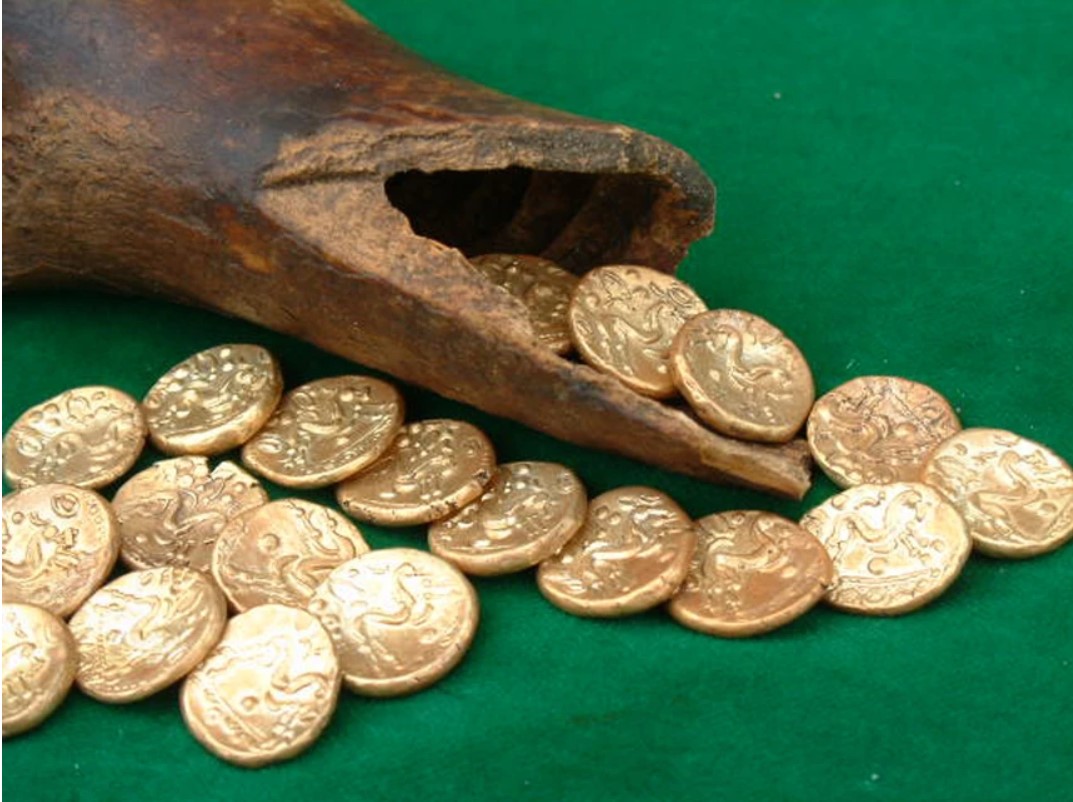Tak to je pecka 👍
2 100 years old gold coins in beef bone
Categories: Nálezy nejenom s detektorem ve Velké Británii a Irsku
The Lynn Museum's new exhibit is an intriguing reminder of a 19-year-old discovery. Specifically, a trove of golden staters from the 1st century BC that were embedded in a hollowed-out bovine femur. They were found with the help of a metal detector during an archaeological excavation of an early medieval burial site.
An Anglo-Saxon burial site was investigated in a valley near the River Heacham in Norfolk by members of the Sedgeford Historical and Archaeological Research Project (SHARP) in late summer 2003. During the excavation, metal detectors were used to make a final search of the site before the season closed. Kevin Woodward - one of the detectorists, was in a rather waterlogged area and was actually not expecting anything special when he detected a very strong signal. But he was really surprised when he found out what was the source of the powerful signal: it was an old beef bone.
When Kevin examined the bone, he found a gold coin at the top of the cavity under a thin layer of dirt. The colleagues called in carefully removed the bone and sent it to the lab for examination. First it was X-rayed, then its "filling" was extracted piece by piece. In total, it contained 19 coins, all of which were gold Gallo-Belgian E staters minted by the Celts in the first half of the 1st century BC in northern Gaul in what is now France.
Subsequent field and detector surveys from the vicinity of the deposit yielded a further 19 coins of the same type. According to the evidence found from detailed analyses, they were all originally part of the contents of a bovine femur, in which they were deliberately placed. It is therefore highly probable that they are a depot, but a votive gift is not excluded.
Coins of this type are found relatively frequently in southern Britain. They were popular and circulated in considerable numbers. Some may also have been produced here. These coins are made of an alloy of gold (mostly) and silver, but appear to be pure gold. Seven coins of the same type were found in the same area between 1997 and 2003. But because they were found by different people individually, they were not declared treasure (at the time, there was a requirement of more than 10 coins in one set) and museums could not claim them.
Roman Němec
Sources: celticcoins.com, find.org.uk, sharp,org.uk








The article is included in categories:
- Archive of articles > Archaeology > Finds and rescue research abroad > Nálezy nejenom s detektorem ve Velké Británii a Irsku
Post
To čumím 
Fantazie... 
Moc pěknej článek 
Něco tady nesedí. 19+19=38 a ne 39, jak je na fotce  Pak se není čemu divit, že se z muzeí ztrácí cenné věci, když je v evidenci často takový bordel. Možná neumí počítat překladatel, tak se muzeím omlouvám
Pak se není čemu divit, že se z muzeí ztrácí cenné věci, když je v evidenci často takový bordel. Možná neumí počítat překladatel, tak se muzeím omlouvám 
Dobrej postřeh  👍
👍
Ty jsi šťoura 😁 komu to prospěje 😆 Článek zajímavý a je štěstí, že to nebylo uloženo do lidské kosti, jinak by se tu zas zvrhla debata 🤭👍😁
Paráda. 
Pěkné počtení a parádní nález. Ty vykopávky připomínají spíše bahenní lázně 
1ks Kevin sundal s vrchu + 19ks je na rentgenu + 19ks dohledávka.  = 39ks = zbytečný tlachy
= 39ks = zbytečný tlachy 
Hustá peněženka 















